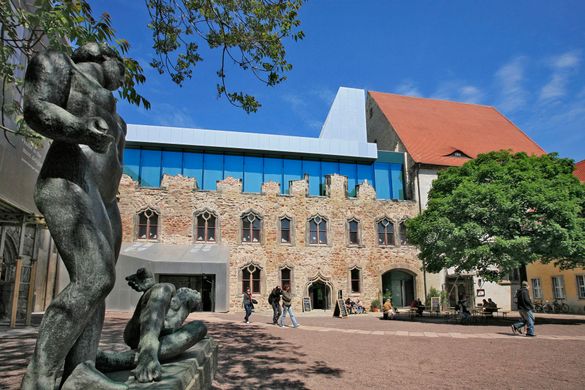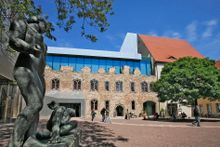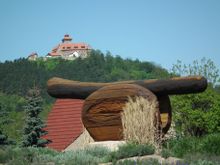 24 Feb 2015
24 Feb 2015
Where other than Germany could there be a museum solely dedicated to fried sausages? Purely rhetorical question, clearly. The Cultural Heart of Germany region of Saxony, Saxony-Anhalt and Thuringia not only offers exactly that but an altogether splendid selection of top notch museums. Here's our round-up:
Starting with the aforementioned 'Deutsches Bratwurstmuseum' in the small town of Holzhausen, only 30 min from Thuringia's state capital Erfurt, where visitors can learn everything about the history and production process of the much loved fried sausage. There's lots of information in particular about the famous Thuringian fried sausage, for many the best in Germany. Even better, a restaurant just next door called 'Bratwurstscheune' (bratwurst barn, brilliant name) to sample all the goodies. The other famous Thuringian B is, of course, the Bauhaus which was founded in Weimar by Walter Gropius in 1919, and the Bauhaus Museum right in the centre of town is a fabulous showcase for what is arguably a design movement like no other.
Number three on our list is Friedenstein Castle in Gotha, a huge early Baroque complex, with its Ducal Museum which has been splendidly renovated to its original state and was re-opened in 2013. Visitors can marvel at works by Cranach, Caspar David Friedrich or Rubens plus one of the oldest Egyptian Collections in Europe. The castle which used to be the home of the Dukes of Saxe-Coburg-Gotha – ancestors of today's British Royal family – also features the world's oldest castle theatre from the 17th century. Erfurt Old Synagogue is the next highlight: Central Europe's oldest synagogue to have survived complete dates back to 1270, and since 2009 the basement and ground floor house a museum featuring the unique artefacts of the so-called 'Erfurt treasure' including Gothic jewellery and a Jewish wedding ring plus a collection of Hebrew manuscripts which belonged to the Erfurt Jewish community.
With number five, we're in the friendly and buzzing city of Halle with its impressive Castle Moritzburg Foundation art museum. The combination of the castle's 15th century stonework with modern architecture makes for a fascinating museum space which is as impressive as the precious collections of paintings, sculptures, porcelain, coins and early photographs of arts and crafts. Saxony-Anhalt's State Museum of Prehistory, also in Halle, is home of a spectacular archaeological find, the Nebra Sky Disk which was discovered in the region in 1999. It dates back around 3,600 years, is the world's oldest known depiction of astronomical phenomena and the bronze disk inlaid with gold symbols also happens to be rather beautiful. In order to walk in the steps of a truly great man, put Luther House in Wittenberg next on your list. For more than 35 years, the Protestant Reformer lived in the Augustineum monastery, both as a monk and professor, and it was here that he wrote the works that changed the world. It's now known as Luther House and opened its doors to the public in 1883 as the largest museum of Reformation history anywhere in the world.
Three left to go and in order to cram in as much as possible we could file the Dresden State Art Collection with its 14 museums as one entry, but that would be cheating so will pick just two of this stunning collection as number 8 and 9: The beautiful Old Masters Picture Gallery right next to the Zwinger is a veritable treasure trove and a must for art lovers from around the world who come to see Raphael's 'Sistine Madonna' or Vermeer's 'Girl Reading a Letter at an open Window', among many other master pieces. The current special exhibition (until 3 May 2015) features 'Romantic Landscapes' by eminent Romantic painters Caspar David Friedrich and Johan Christian Dahl.
Literally just round the corner, the Green Vault, our penultimate stop, is as dazzling as a museum can get: The 'Grünes Gewölbe' is one of Europe's richest treasure chambers and the collection so abundant that it is divided into two separate permanent exhibition areas. The 'Historical Green Vault' reconstructs Augustus the Strong's treasure chamber, featuring enchanting works of art in a Baroque setting, displayed on gilt consoles in front of mirrored walls. The 'New Green Vault' shows 1,000 selected masterpieces in cabinets made of special antiglare glass. Let's just say, the ladies will in particular love the Green Vault's out of his world jewellery and display of gold, silver and gemstones. And be equally frustrated that they'll have to leave it all behind.
Finishing off our tour we'll arrive in Leipzig, Saxony's more edgy sister to elegant Dresden, where the Grassi Ethnographic Museum is not just one of the most influential German institutions of this type but also a very fine example of art deco architecture. It combines the Museum of Applied Art, the Ethnological Museum and the Museum of Musical Instruments and walking through the spacious exhibition rooms is like a journey around the world. Four landscaped courtyards not only complement this impressive complex but also provide the perfect space for museum walkers to rest their tired feet.
Travel information:
Easy access to the Cultural Heart of Germany with Cityjet from London City to Dresden, Ryanair to Leipzig and Germania from London Gatwick to Erfurt-Weimar. All major airlines to Berlin.
The Cultural Heart of Germany online:
Website: www.culturalheart.info
Facebook:www.facebook.com/CulturalHeartofGermany
Twitter: www.twitter.com/CulturalGermany
For more information and enquiries, please contact:
B Connects. Barbara Geier Content Services
On behalf of Cultural Heart of Germany (Saxony, Saxony-Anhalt, Thuringia)
barbara@bconnects.net, phone 07983 242 195



